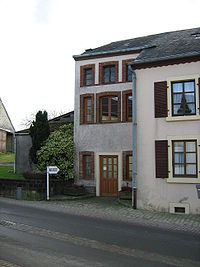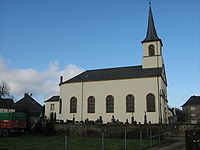
Nospelt
Encyclopedia

Communes of Luxembourg
The communes of Luxembourg are the lowest nation-wide administrative division in Luxembourg. They conform to LAU level 2.Within the hierarchy of administrative subdivisions, communes come directly below cantons, which are directly below districts. Communes are often re-arranged, being merged or...
of Kehlen
Kehlen
Kehlen is a commune and town in western Luxembourg. It is part of the canton of Capellen, which is part of the district of Luxembourg., the town of Kehlen, which lies in the centre of the commune, has a population of 1,627. Other towns within the commune include Dondelange, Keispelt, Meispelt,...
, in south-western Luxembourg
Luxembourg
Luxembourg , officially the Grand Duchy of Luxembourg , is a landlocked country in western Europe, bordered by Belgium, France, and Germany. It has two principal regions: the Oesling in the North as part of the Ardennes massif, and the Gutland in the south...
. , the village has a population of 754. It is known above all for its potters who were particularly successful during the 19th century.
Location
Nospelt lies 15 km north west of Luxembourg City at a height of 320 m on a plateau between the MamerMamer River
The Mamer is a river flowing through Luxembourg, joining the Alzette at Mersch. It flows through the towns of Mamer and Kopstal. The river is a tributary to the Moselle river....
and Eisch
Eisch
The Eisch is a river flowing through Belgium and Luxembourg, joining the Alzette on its left in Mersch. It flows through the towns of Eischen, Hobscheid, Septfontaines, and Marienthal....
rivers. It is a quiet rural village with pleasant houses and streets.

History
With the recent discovery of Celtic tombs in the area, it appears that the history of Nospelt stretches back until before the Roman conquestRoman Empire
The Roman Empire was the post-Republican period of the ancient Roman civilization, characterised by an autocratic form of government and large territorial holdings in Europe and around the Mediterranean....
. The finds at Scheierheck near neighbouring Goeblange
Goeblange
Goeblange is a village in the commune of Koerich, in southern Luxembourg about 13 km west of Luxembourg City. , the village has a population of 425.-Location:...
and at Kreckelbierg, just north-west of the village of Nospelt, contain a range of articles including wine flagons, articles of pottery, spurs, knives, lances and a lantern testifying to the nobility of those buried. It is thought the tombs might belong to chieftens from the Titelberg
Titelberg
Titelberg is the site of a large Celtic settlement or oppidum in the extreme south west of Luxembourg. In the 1st century BC, this thriving community was probably the capital of the Treveri people...
settlement near Pétange
Pétange
Pétange is a commune and town in south-western Luxembourg. It is part of the canton of Esch-sur-Alzette, which is part of the district of Luxembourg. Pétange lies on the borders with both Belgium and France....
. It is interesting to note that some of the artefacts including a tall amphora
Amphora
An amphora is a type of vase-shaped, usually ceramic container with two handles and a long neck narrower than the body...
came from as far away as the Mediterranean, showing the extent of trade with other regions at the time.
Merovingian tombs from the 7th century have been found at Telpescholtz between Nospelt and Dondelange
Dondelange
Dondelange is a village in the commune of Kehlen, in south-western Luxembourg. The village has a historic chapel, and a large historic mansion. , the village has a population of 143. The surnames Dondlinger and Dondelinger are derived from the name of this village....
. The area thus seems to have been inhabited over the centuries without interruption.
The origins of Nospelt's pottery
Pottery
Pottery is the material from which the potteryware is made, of which major types include earthenware, stoneware and porcelain. The place where such wares are made is also called a pottery . Pottery also refers to the art or craft of the potter or the manufacture of pottery...
production go back to 1458. By the early 19th century, there were 17 different potters shops in the village. Nospelt was recognized as the centre of Luxembourg's ceramics
Ceramic
A ceramic is an inorganic, nonmetallic solid prepared by the action of heat and subsequent cooling. Ceramic materials may have a crystalline or partly crystalline structure, or may be amorphous...
industry until 1914 when Nicolas Schneider (1868-1941), after whom a street is named,lit his kiln for the last time. Today a museum in his old workshop commemorates the history of the art with exhibits from Echternach
Echternach
Echternach is a commune with city status in the canton of Echternach, which is part of the district of Grevenmacher, in eastern Luxembourg. Echternach lies near the border with Germany, and is the oldest town in Luxembourg....
and elsewhere in Luxembourg
Luxembourg
Luxembourg , officially the Grand Duchy of Luxembourg , is a landlocked country in western Europe, bordered by Belgium, France, and Germany. It has two principal regions: the Oesling in the North as part of the Ardennes massif, and the Gutland in the south...
. There is also a road called "rue des potiers", "Potters' Road".

The church
Today's church stands on the site of the former chapel, dedicated to St Thomas, of which the oldest record dates back to 1685. The new church, completed in 1852, was built in the Empire styleEmpire (style)
The Empire style, , sometimes considered the second phase of Neoclassicism, is an early-19th-century design movement in architecture, furniture, other decorative arts, and the visual arts followed in Europe and America until around 1830, although in the U. S. it continued in popularity in...
with rounded windows and a bell tower above the porch. The 17th century pietà
Pietà
The Pietà is a subject in Christian art depicting the Virgin Mary cradling the dead body of Jesus, most often found in sculpture. As such, it is a particular form of the Lamentation of Christ, a scene from the Passion of Christ found in cycles of the Life of Christ...
on the altar comes from the original chapel. Renovation work was carried out in 1986.
Emaischen festival
Every year on Easter MondayEaster Monday
Easter Monday is the day after Easter Sunday and is celebrated as a holiday in some largely Christian cultures, especially Roman Catholic and Eastern Orthodox cultures...
, Nospelt celebrates its former potteries with an open-air Emaischen
Emaischen
The Emaischen festival is celebrated every Easter Monday in the village of Nospelt in the south of Luxembourg as well as in the Fish Market in the City of Luxembourg. Little earthenware whistles shaped like birds and known as peckvillercher are a special feature of the event...
festival where amateur potters demonstrate their art and wares. A special attraction is the peckvillercher, a bird-shaped whistle associated with pottery manufacture in various parts of Europe. According to tradition, every child received a whistle from his parents on Easter Monday each year.

